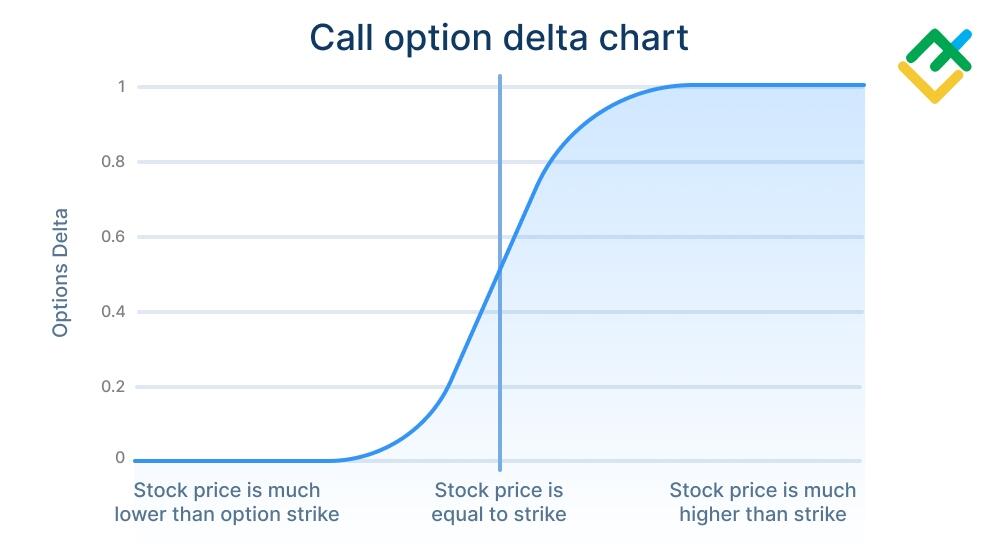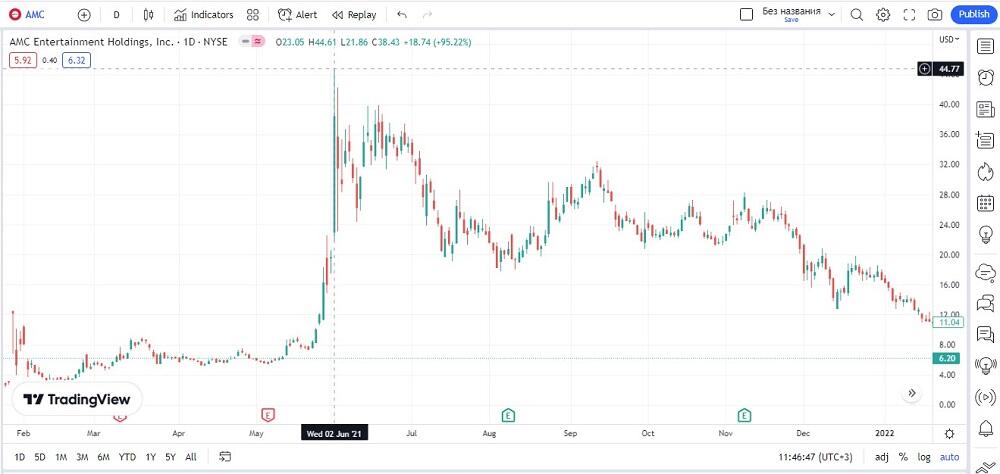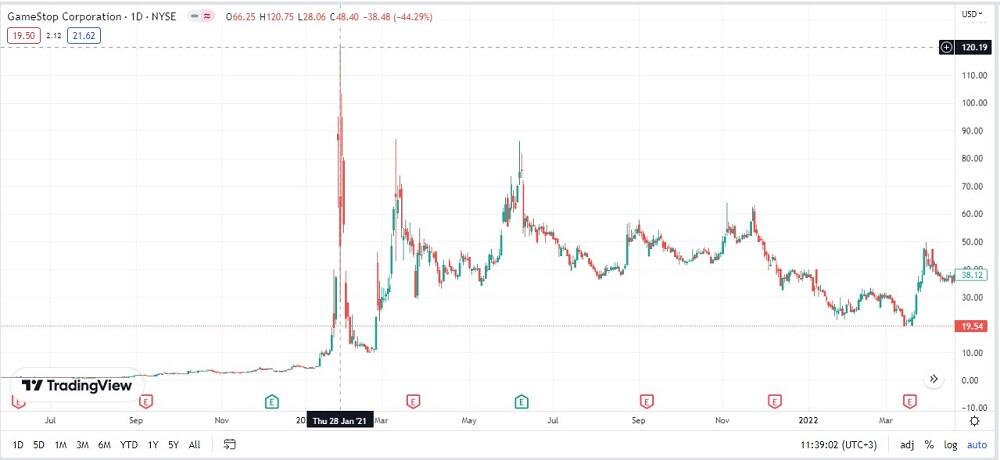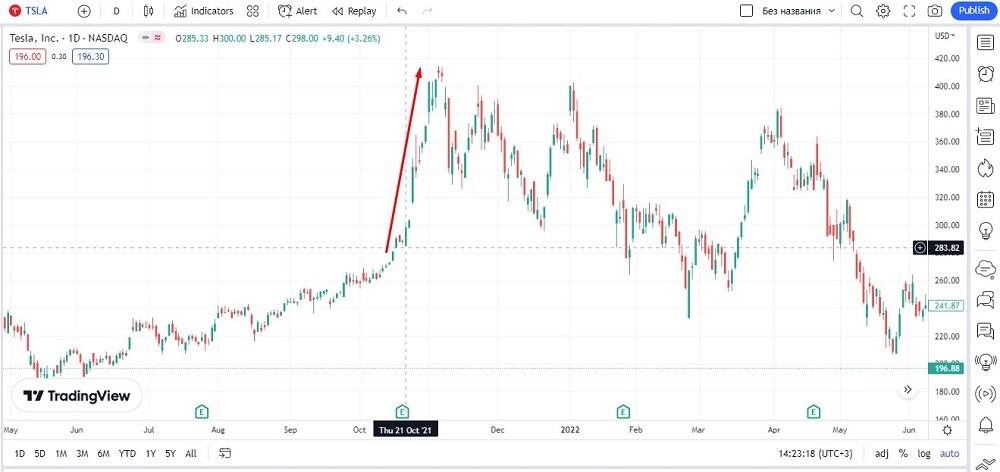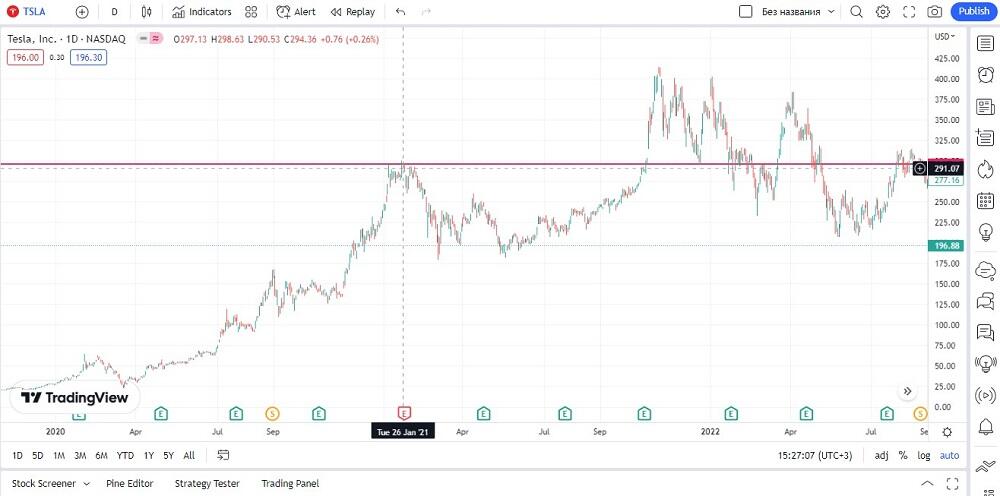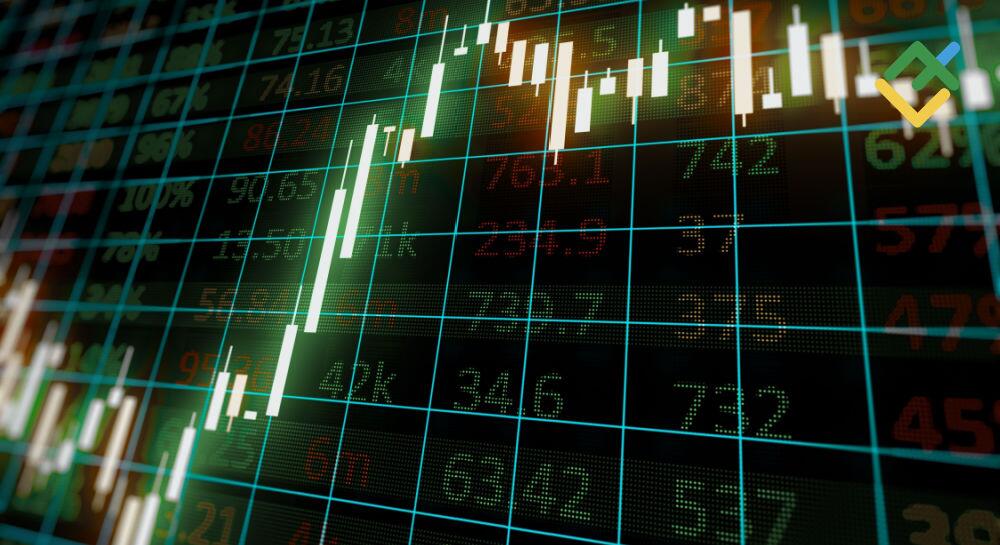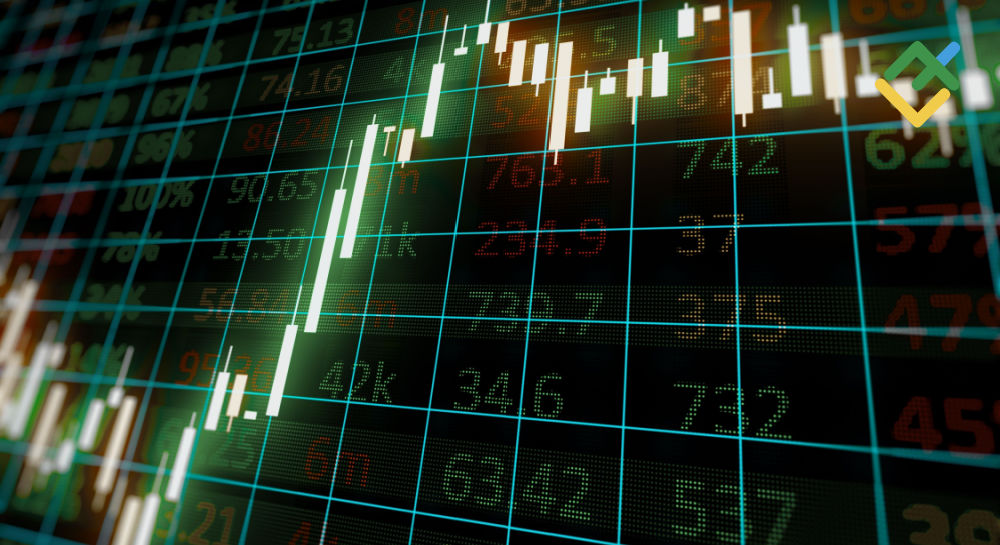
In this article, you will learn what the gamma squeeze is and how it works, at what moments the situation preceding it arises, and how an investor can make money on it. The article also includes real examples of gamma squeezes from the stock market’s history, potential risks, and how to minimize them. One of the most illustrative examples of the gamma squeeze mechanism is the AMC Entertainment stock’s performance.
A few years ago, investors betting that AMC stock would rise could make over 1,000% in one week on a gamma squeeze. Despite the company’s $10 billion in debt and financial losses, the AMC stock skyrocketed. The company was on the verge of bankruptcy, but technical factors related to the gamma squeeze caused the stock price to surge sharply, making AMC one of the fastest-growing companies of the time.
The article covers the following subjects:
Major Takeaways
- A gamma squeeze is a sharp rise in the stock price caused by market makers hedging their options positions.
- The situation occurs when investors buy call options en masse, forcing sellers to purchase the underlying stock to manage risk.
- The gamma squeeze amplifies the rise in the stock price as the delta increases and further hedging purchases are made.
- One vivid example of a gamma squeeze is the AMC Entertainment stock’s performance in May 2021, when its price soared by more than 1,000% in a week.
- A gamma squeeze provides traders with an opportunity for quick profits but carries high risks due to a sharp surge in volatility.
- The main signs of a gamma squeeze are a sharp increase in call options volume, a lack of fundamental reasons for the stock to rise, and active hedging purchases by market makers.
What is a Gamma Squeeze?
A gamma squeeze is a sharp jump in the stock value in a short time caused by the fact that large investors are forced to buy more stocks to hedge their call options positions. Gamma squeeze and short squeeze are often used as synonyms in many sources. However, there are key differences between these terms.
How a Gamma Squeeze Works
First, you need to understand what a short squeeze is. A short squeeze is a situation when many investors are forced to buy stocks simultaneously to close short trades, which increases the demand and stock price.
Short squeeze works as follows:
- A trader opens a short trade on a stock, borrows stocks from a broker against cash collateral, and sells them at the current price. In fact, the trader does not own the stock and must buy it in the future to pay off the debt. The process is based on the assumption that the stocks will fall in price, and the trader will buy them at a lower price and repay the debt.
- For one reason or another, stocks begin to rise in price, and short traders quickly lose money. When the cash collateral becomes insufficient, the broker closes the short trade, buys the stocks with the trader’s collateral, and closes the debt (closing the trade by stop-out). Or the trader closes the deal ahead of schedule without bringing the situation to an even greater loss.
- The additional volume of purchases that appeared due to the forced closing of short trades increases demand, while large trading volumes push the price up even faster.
A short squeeze is a mass closing of short trades by stop loss and stop out due to a sharp increase in an asset’s value. Gamma squeeze occurs in a similar way, but has a key difference. A short squeeze appears on the market where stocks are directly traded. Gamma squeeze appears on the derivatives market, that is, the options market.
To understand what causes the gamma squeeze, I will describe an options trading model. Some of the definitions are presented below:
- An option is a contract that gives the buyer the right (but not the obligation) to trade the underlying asset (stocks in particular). A call option gives the buyer the right to buy stocks in the future, while a put option allows the buyer to sell stocks at the strike price in the future.
- The strike price is the option exercise price specified in the option contract. The price at which the buyer of a call option will buy the stock from the seller at expiration, regardless of the current price.
- The premium is a fixed amount that the buyer of an option pays for a trade.
A trader who buys a call option expects higher stock prices. A trader who buys a put option expects the stock price to fall.
- Example. Now the stock of company A is worth 100 USD. The trader understands that the stock price will rise to 120 USD in a month. He wants to buy 50 stocks but doesn’t have 5000 USD (50*100 USD). Then he buys a call option for a small premium (30 USD), which gives him the right to buy 50 stocks in a month at a strike price of 100 USD. The seller will be obliged to sell him these stocks. If the stock rises to 120 USD, the seller will suffer losses, and the buyer will profit. If the stocks fall in price, the contract does not make sense to execute since the seller earns a 30 USD premium, and the buyer loses 30 USD.
- Delta shows how much the option price will move relative to a move in the underlying asset. For example, if a stock has risen in price by 1 USD, while a call option by 10 cents, then the Delta coefficient is 0.1 or 10%. For a call option, the delta is positive, and for a put option, it is negative.
The price of a call option depends on the strike of the contract, (and) the current price. The higher the current price relative to the strike, the more expensive the option. In this way, the profit of buyers who, by the expiration of the option contract, want to buy stocks at a predetermined lower strike price, will be greater. Also, the option price is affected by the expiration date – the closer it is, the more likely it will be executed.
Below is a diagram of the option price change dependence on the underlying stock price:
- Gamma is related to the delta, as it measures how the latter changes as a stock’s price shifts up or down.
The “gamma squeeze” comes from the name of the gamma coefficient.
- Hedging is risk insurance by market makers, which consists in opening opposite positions on the underlying asset.
If a trader buys a call option, then a market maker acts as the seller of the option who can influence stock prices. To partially insure against a possible loss if an option is executed, a market maker must hedge his position. Only part of the position is hedged. If the market maker sells a call option to the buyer, he loses money if the stock price rises but partially compensates for the loss due to the purchased stocks.
- Example. The call option’s strike price is 150 USD, and the current price is 100 USD. In this situation, the loss in the premium amount is borne by the option buyer since the option has not yet reached the strike. The market maker, assessing the potential for price growth, calculates the number of stocks that need to be bought to insure against price growth. The stock rate is rising. The closer the current price is to the strike, the higher the probability that the option will be executed and the market maker will have to sell the stocks at a loss. The higher the risk for a market maker to execute an option, the more he needs to buy stocks to hedge. If the price crosses the strike level and rises even higher, the buyer will present the option by the end of expiration for execution with 100% probability. Thus, the position must be 100% insured.
The essence of gamma squeeze. When market makers realize there is little to no chance of a price increase, they easily sell call options. In a falling market, the risk is minimal, so the hedging amount is small. However, the market grows contrary to the forecast, and investors buy stocks instead of selling.
An increase in the already large number of market participants buying call options increases the risks and forces market makers to increase the hedging rate due to the growth of delta and gamma coefficients. Market makers are forced to buy additional stocks on the market. But additional volumes again push the price up, the coefficients change again, and market makers are again forced to buy more securities. This is where the gamma squeeze occurs, sharply pushing the rate up. When the option expires, the market maker sells the stocks, and their price plummets.
Gamma Squeeze Examples
Gamma squeezes are more common in stocks of relatively small companies since the securities of large companies are more difficult to manipulate. Nevertheless, in the stock market’s history, there are examples of gamma squeezes of well-known companies whose stocks grew by more than 500-1000% during a squeeze.
AMC Gamma Squeeze Explained
In January 2021, the management of the AMC Entertainment Holdings cinema chain drew the investor community’s attention to the possible initiation of bankruptcy proceedings. The entertainment industry has been hit hard by COVID-19, and the once-largest chain in the world has been in crisis for a long time.
The popular Reddit community of Wall Street Bets has become an unexpected way to rescue AMC Entertainment. It is a movement against hedge funds and Wall Street institutional investors who sell stocks of failing companies en masse, pushing them into bankruptcy even faster.
The rescue of AMC Entertainment included the following steps:
- Major investors, who received a signal from the top management of the network at the beginning of 2021 about structural problems, began to bet massively on short stocks. The number of short trades and put options increased.
- The renewal of the partnership with Universal (which at the time had been put on hold due to controversy) gave AMC Entertainment little hope. The news that AMC Entertainment managed to raise 917 million investments led to an increase in the price by 245% (to 17.36 USD per stock) on January 25, 2021. This was one of the signals to start putting pressure on sellers.
- The Reddit community began encouraging traders to buy AMC Entertainment stocks in May. Mass purchases by retail investors have led to the fact that market makers who bet on the fall were forced to add up to hedging positions on call options.
The gamma squeeze process saved the company from bankruptcy. And although the share price then returned to its previous level, AMC Entertainment gained a temporary respite.
Gamestop Gamma Squeeze Explained
A similar situation occurred a few months earlier with GameStop stocks, a company that sells video games and game accessories.
GME squeeze is a combination of a short squeeze and a gamma squeeze. With negative GME price forecasts, retail traders could concentrate enough volume of purchases to move the price higher. They were buying OTM call options with a low delta. An OTM call option is an out-of-the-money option whose strike price is higher than the current value. That is, they deliberately increased the volume of purchases and pushed the current price to the strike price. The faster the price approached the strike, the faster the delta grew. Market makers were forced to buy more stocks to hedge the option and make the delta neutral, raising their rate even more.
Tesla Gamma Squeeze Explained
In November 2021, a sharp upward move replaced Tesla’s slowly rising price trend.
After a record stock surge of more than 800% in 2020, many retail investors have decided that the price is too high. The situation was also aggravated by the unpredictable actions of Elon Musk. Therefore, it is unsurprising that market makers have bet on a price reduction, which moved away from the historical high.
Nevertheless, traders continued to buy stocks, which caused a gamma squeeze. The chart above shows a price formation pattern with a breakout of resistance. A sharp price rise began precisely after the breakout of the last high, where many sellers set stop orders.
What Causes a Gamma Squeeze?
Causes of Gamma Squeeze:
- Unexpected news, such as economic data or central bank decisions, cause additional stock buying activity, market volatility and gamma squeezes.
- High volatility. If the underlying stocks become more volatile, this leads to more demand for options as they become more valuable. This, in turn, leads to an increase in demand for the underlying asset and to its growth.
- Short trades. If there are a large number of short orders in the market, this can lead to a gamma squeeze. When the price of the underlying asset begins to rise, those who hold short positions are forced to close them, which leads to additional demand for the asset and increase of its rate.
- Limited access or low liquidity. If access to the underlying asset is limited (for example, due to a limited number of stocks), this can lead to a gamma squeeze. In this case, the growing demand for options leads to an increase in the underlying asset’s price, as investors compete for a limited amount of the asset.
Another reason for the occurrence of gamma squeeze is the collusion of buyers. Market makers are not interested in the price of a call option reaching the strike. Because they will have to execute it at a loss. Private investors are not able to compete with market makers on long time frames, but are able to generate enough buying volume in the short term by betting on short-term call options to force market makers to increase their hedging. This is what happened in the case of GME and AMC.
Gamma Squeeze vs. Short Squeeze
The differences between short squeeze and gamma squeeze are as follows:
- A short squeeze occurs directly on stocks at the time of the forced closing of short trades. Gamma squeeze occurs on options due to the need to hedge risks, namely, to buy additional stocks to secure options.
- Short squeezes are also caused by stops on short trades by individual traders, which push the price up. The main reason for the gamma squeeze is market maker hedging.
- A short squeeze affects the rate of price change to a lesser extent than a gamma squeeze.
Many sources cite AMC and GameStop as examples of both a short squeeze and a gamma squeeze. This is because trading in the derivatives market directly depends on stock trading. If a short squeeze occurs in the stock market, then it automatically affects the options market. Both types of squeezes occur at the same time, and a synergy effect is triggered. Despite the fact that these squeezes occur for different reasons, the trader sees the same result in the chart, namely, a sharp abnormal price increase.
How Long Does a Gamma Squeeze Last?
Gamma squeeze can last from several days to several weeks. The active phase of growth from the moment the price passes the critical level (the level after which the mass closing or hedging of short positions begins) most often lasts several days, but can end within a few hours. Then the regulators intervene, the buyers’ activity falls, and the price reaches its peak.
The transition from the peak to the price preceding the gamma squeeze can last from several weeks to several months. The sharpest decline occurs in the first week, when the initiators of the squeeze actively get rid of assets.
Examples:
- GameStop. The squeeze, which began at the end of January 2021, pushed the price to an all-time high in a week. The price returned to pre-squeeze level in 10-14 days with the same sharp decline and gap down.
- AMC. The gamma squeeze, which began at the end of May 2021, peaked just a week later. The price held out for another three weeks at close to maximum levels. Then a gradual decline began, which lasted more than ten months.
- Tesla. About 15 days passed from the moment the gamma squeeze began until the price reached its high, during which the quotes grew by more than 50%.
Each gamma squeeze is unique in its own way, so its duration is difficult to predict.
How to Trade During a Gamma Squeeze?
Fundamental trading recommends novice traders to avoid any periods of abnormal volatility, since the price at this moment is almost unpredictable. Therefore, it is better to close positions before a squeeze. But if you want to take risks, then the trading algorithm during gamma squeeze is as follows:
- Look for securities on which gamma squeeze is possible. Since the short squeeze and the gamma squeeze are very similar, you can use fundamental metrics that indicate the volume of short trades of market makers. Also, follow the information in the investor communities.
- Open long trades when the price starts to rise. Sell as quickly as possible to avoid a trend reversal.
- Use stop-losses.
One of the options for an investment strategy is to open trades when the price breaks out a key resistance level. But in this case, there is one significant risk of missing the points of a timely opening of a long trade, and then a timely exit from the market. A rocketing price prompts the obvious decision to buy stocks while there is a sharp increase. But the active phase of the gamma squeeze in most cases lasts a maximum of a few days. The regulator often intervenes in it, stopping trading as soon as the growth dynamics exceeds a certain percentage. Due to slippage and gaps, trader orders can be executed at less favorable prices, including at a loss.
Squeeze indicator
The most common gamma squeeze indicators are Bollinger Bands and Keltner Channels. Both indicators display the range of prices in the market and show how fast the price is moving in one direction or another. If the range narrows and prices begin to fluctuate in a narrow range, this indicates a gamma squeeze.
You can also use the RSI and MACD oscillators as additional indicators. For example, an RSI below 30 indicates that the stock is oversold and the price will soon reverse up. A sharp price reversal with increasing volatility can lead first to a short squeeze and then to a gamma squeeze.
Conclusion
- Gamma squeeze is an increase in the price of the underlying asset in the options market caused by the fact that market makers acting as sellers of call options are forced to buy stocks to hedge risks. Additional volumes of purchases accelerate the price rise. Thus, the more purchases, the faster the price rises.
- A gamma squeeze and a short squeeze occur at the same time, but a gamma squeeze leads to a sharper and stronger price hike because market makers are directly involved in it.
- Gamma squeeze occurs more often when trading stocks with a negative outlook and those that are predominantly used in short trades. A sharp rise begins after the breakout of a key resistance level.
- Gamma squeeze is abnormal volatility. You can make money on it if you buy stocks on time, and then sell them at the maximum price. But at such times, gaps and slippages often occur, so regulators and brokers stop trading options and stocks.
Gamma Squeeze FAQs
This is a situation in the stock market, when an increased demand for call options (to buy) leads to a sharp increase in the underlying asset’s price. When most traders simultaneously buy call options on the same asset, the sellers are forced to additionally buy the underlying asset to cover their future obligations. This leads to an increase in demand for the asset, which in turn leads to a further price increase.
It’s bad for short traders. If the price rises, then their positions will be closed by stop loss or stop out. Major investors are forced to incur additional costs by purchasing additional stocks at a rising price to hedge option risks.
For buyers gamma squeeze is good. They can capitalize on a sharp price rise if they manage to sell shares at the peak of growth.
Gamma squeeze is relatively rare compared to short squeeze. The most famous examples of the gamma squeeze are the rise in the value of GameStop and AMC Entertainment stocks.
This term is related to the Greek letter gamma, which is used in option theory to measure the rate of delta change (the change in the option price relative to the change in the underlying asset’s price). At moments of gamma squeeze, there is a sharp change in the range of options.
A short squeeze occurs during stock trading due to the forced closing of short trades when the price rises. Gamma squeeze occurs during options trading due to the need for market makers to hedge positions on options contracts at a rising price.
The price soars up sharply, after which there is a steep or smooth decline due to the sale of previously purchased stocks. During a downward movement, gaps may appear.
It is impossible to calculate exactly which gamma squeeze was the largest, since there are no corresponding indicators for this. Some sources claim that the largest quadratic gamma squeeze occurred in September 2020. It applied to the entire options market.
There are no gamma squeeze indicators. Classical channel indicators and oscillators are used instead. For example, a squeeze of the price channel may indicate that volatility will soon increase in the market, which may cause a gamma squeeze.
It occurs when sellers of stocks entering short trades are forced to buy stocks to protect their positions when the price goes up. This leads to additional demand and a further price increase, which creates a cycle called a short squeeze.
A situation where the cryptocurrency rate rises sharply due to the fact that market makers are forced to buy more of it in order to pay off call options in the future.
The content of this article reflects the author’s opinion and does not necessarily reflect the official position of LiteFinance. The material published on this page is provided for informational purposes only and should not be considered as the provision of investment advice for the purposes of Directive 2004/39/EC.
{{value}} ( {{count}} {{title}} )
This post is originally published on LITEFINANCE.

